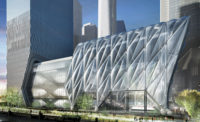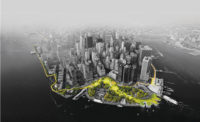The Los Angeles structural engineer Richard Bradshaw talks about his first experience with large-scale prefabricated construction in terms that are less than affectionate. “It never really made sense to me,” he says now, more than 45 years later. Bradshaw worked with architect Welton Becket, who was collaborating with United States Steel and the Walt Disney Company to build a hotel, the Contemporary Resort, for Disney’s theme park in Orlando.
The three collaborators conceived the hotel, which opened in 1971, to demonstrate the potential for prefabrication in steel construction. U.S. Steel manufactured the nearly 500 rooms for the building’s main trapezoidal tower in a purpose-built factory on Disney property a few miles from the site. There, workers not only built the individual room chassis—each approximately 9 feet high, 15 feet wide, and 30 feet long—but also installed interior finishes and furniture, including the television set. Once the modules arrived at the site, they were craned directly into the super-structure and hung on cables from its top bracing. To this day, each room is suspended above the still-operating hotel’s central atrium.
Like many prefabrication projects, the Disney hotel had several aims. These included accelerating construction, saving money, and illustrating Walt Disney’s vision of the city of the future. But “this was the end of their experiment,” says Bradshaw. Prefab at this scale did not immediately take off, he says, because of the immense investment needed to establish a nationwide factory network; the lack of predictable, precise execution in the precomputer era; and relatively low labor costs for conventional construction.
However, the dream certainly isn’t dead. For if the aims of prefabrication in architecture remain the same, the ways in which architects harness its potential now vary widely. Contemporary prefabrication operates at several scales, including that of specific systems like mechanical and plumbing distribution, building components such as facade units, and individual modular spaces like bathrooms, in addition to entire buildings. Prefabrication also represents a substantial share of new single-family residential construction.
Building typologies with significant programmatic repetition—hotels, multifamily housing, and student housing—still reap the greatest benefits from prefabrication. In 2004, the Dutch architecture firm Concrete conceived of its first prefabricated hotel project, for the citizenM hotel brand. The Amsterdam hotel included a concrete core of elevators, stairs, and service risers and a concrete superstructure plinth upon which modular guest rooms, built by the Polish manufacturer Polcom, were stacked. The architects designed the rooms so that a single fully furnished module fit within a shipping container, for ease of transport.
The chain now has nine hotels. On a recently completed 370-room citizenM near the Tower of London, contractors stacked 30 units a week, shortening construction time by several months when compared to a conventionally built hotel. The brand’s newest project, currently under construction and slated to open in 2017 on New York’s Lower East Side, features 300 prefabricated guest rooms on top of a three-story concrete plinth. Concrete worked with local firm Stephen B. Jacobs Group to take their concept through construction. To save time, building department inspections for the rooms are being conducted in Polcom’s factory, with city inspectors from New York, so when each module arrives on-site, it is ready for installation.
“We didn’t start with the idea of making it prefabricated,” says Concrete’s Erikjan Vermeulen, the firm’s head of architecture. “We started with the idea of creating a better experience with less money, designing smarter space in a room of limited size, and then giving that saved space back with a ground-floor living room where people could socialize.” The original citizenM concept featured conventionally built infill corridors, but Vermeulen says that created too many unknowns on-site that delayed construction. The new hotels incorporate the corridor into the room module. On-site, the contractors connect the plumbing, mechanical, and electrical services for each module; the highest floor of the concrete plinth—usually at level three—includes the building services equipment that feeds upward through the 15-story guest room tower.
Prefabrication helped San Francisco–based architect David Baker to reduce on-site construction time by nearly a year on a housing project in Union City, California. Baker’s client needed to accelerate construction to qualify for public money for transit-oriented development. So the architect took a modular approach for the 243 units, which include live-work lofts and one- and two-bedroom apartments.
Working with Guerdon, a manufactured-housing fabricator in Boise, Idaho, Baker conceived of the project, called Union Flats, with wood-framed modules 15 feet, 4 inches-wide, 11 feet high, and up to 74 feet long to maximize shipping efficiency. Two modules create two one-bedroom apartments mirrored across a corridor through the middle, while three modules are needed for two-bedroom apartments in a similar configuration. To vary the floor plan, contractors can cut the modules in half through the corridor on-site.
As with the citizenM hotel rooms, inspections are conducted in Boise, so the units can remain locked throughout installation to avoid damage to the interiors. Each module’s framing sits within a steel chassis. Once this is set into place, structural tabs on the modules are fastened to adjacent modules to create a consolidated structural system.
“Before the recession, we had a number of modular projects, but then framers needed jobs and costs came down for conventional construction,” Baker says. “Now, modular wood-framed construction is competitive again with union-labor costs in many cities.” In a factory, even union labor often costs less, he says, and the controlled conditions lead to higher quality, simpler construction methods, and fewer hazards compared to on-site circumstances. Although Baker is currently working on several modular projects, he believes prefabrication can sometimes have a negative impact on design, since shipping constraints prescribe dimensions, and connections for building services often dictate kitchen and bathroom placement.
Prefabrication can also compromise the appearance of a modular housing project, especially if the design emphasizes the technology’s inherent repetitiveness. Baker notes that the Union Flats project looks indistinguishable from the conventionally constructed housing project his firm designed across the street. Since the units arrive on-site as water-proofed boxes wrapped in a single-ply membrane, a variety of cladding systems can be applied after they are stacked to conceal the joints between modules.
The biggest challenge to prefabrication is the irregularity of sites in dense urban environments, says Baker, since maximizing leasable living space often outweighs construction-cost savings from standardization. In dense cities, instead of full dwelling units, prefabricated kitchen and bathroom modules make the most sense, he says.
Baker also recommends that owners and architects weigh potential construction-cost savings against the expense of a large on-site crane, which often accounts for the single-most significant construction expense for multifamily housing. “If you’re good at it, you’re lifting four units a day, but if you’re really good, you can lift 12 units a day,” Baker says, noting that at Union Flats they averaged between 11 and 12 modules a day. He predicts that prefabricated multifamily housing could one day displace conventionally built apartment buildings in California, given the endemic housing shortages in the state.
Modular construction is also making inroads in health-care facilities, but not in the manner one might expect. Prefabrication has not been widely adopted for hospital-patient rooms. However, architects have found that some individual systems within these complex buildings lend themselves particularly well to prefabrication.
Designers with NBBJ’s Columbus, Ohio, office initially developed a prefabrication approach to patient toilet rooms, head walls, casework, and building-services utility racks for the Miami Valley Hospital in Dayton, which opened in 2010. The client was interested in the idea of the universal patient room, where standardized systems and architecture could serve a variety of clinical situations, from intensive care to basic medical-surgery nursing units. But after studying the potential for a fully prefabricated room—akin to the citizenM hotel approach—and finding scant possibility for savings, the architects worked with construction manager Skanska toward more discrete prefabricated components to realize savings of time and money.
“We learned many lessons on Miami Valley,” says Tim Fishking, an NBBJ principal. The biggest lesson was minimizing the need for warehouses to temporarily store prefabricated components prior to on-site installation. So for its second prefabrication project, the OhioHealth Riverside Methodist Hospital, which opened in 2015 in Columbus, NBBJ worked with the contractor to streamline the schedule to engender a “just-in-time” approach for the prefabricated systems. This allowed elements like head walls and utility racks to be shipped to the site for the 224-bed, 437,000-square-foot neuroscience, vascular, and cardiac-care hospital as soon as they were ready.
At Riverside, whole mechanical and electrical distribution racks were laid out in the prefabrication shop based on the hospital’s corridor design and GPS coordinates established on the construction site. Joints in the racks aligned with the radius of the corridor’s curve, so each 20-foot-long and 8-foot-wide section could be transported to the site and then hung from the ceiling and attached to adjacent sections to create continuous runs of services such as chilled and hot water, oxygen, nitrogen, and fire sprinklers. “You didn’t have this scenario of ‘who got there first’ that forces trades to reroute their work around others’,” says Fishking. “It also improves the owners’ ability to maintain the facility, because they know each rack is identical.”
Prefabricated systems and components at Riverside also included single-stall toilet rooms, head walls in patient bays and exam rooms, utility racks above the operating rooms, plumbing zone valve boxes, and even entry canopies. The project was complete six months before the planned opening date, an accomplishment Fishking attributes, in large part, to prefabrication.
Ryan Hullinger, also a principal in NBBJ’s Columbus office, says successful prefabrication depends on getting it right in virtual design. “So much work has to go into testing patient rooms for dozens of clinical scenarios to ensure it works in those situations,” says Hullinger, who also recommends extensive physical mock-ups.
Some of the firm’s upcoming hospital projects include extensive renovation, where Hullinger envisions even more benefits for a prefabrication approach. “A typical hospital-wing renovation includes demolition and significant downtime while you build new rooms,” he says. “With prefabrication, you could build the patient rooms off-site during the demolition phase and vastly reduce that downtime.” It’s similar to the schedule savings on new construction projects, where site preparation often occurs in parallel with the factory fabrication work.
With the renewed interest in prefabrication, it’s sometimes easy to overlook the fact that unitized facade systems remain the most common form it takes in buildings. But some industry experts believe that prefabrication is also the answer for facades with complex geometries that would otherwise have to be achieved through time-consuming on-site labor. Technologies such as 3-D printing or robot-enabled construction could pave the way for envelopes with even more exuberant shapes and a higher level of intricate detail. But, regardless, the aims will be the same as they have always been—to build faster, better, and more cheaply.
|
Continuing Education

To earn one AIA learning unit (LU), including one hour of health, safety, and welfare (HSW) credit, read “Pushing Prefabrication,” review the supplemental material listed below, and complete the online test. Upon passing the test, you will receive a certificate of completion, and your credit will be automatically reported to the AIA. Additional information regarding credit-reporting and continuing-education requirements can be found online at continuingeducation.bnpmedia.com.
Supplemental Material Building the Disney Contemporary Resort U.S. Steel
A prefabrication Case Study: Miami Valley Hospital NBBJ
Treetop Entertainment
Learning Objectives 1 Describe how project teams are using prefabrication as an alternative to traditional construction methods and explain how the approach can save time and money, and reduce construction waste. 2 Outline which building typologies and components are best suited for prefabrication. 3 Explain why off-site construction can result in better-performing buildings and safer construction sites. 4 Discuss the role of virtual construction and digital technology in prefabrication.
AIA/CES Course #K1609A
For CEU credit, read "Pushing Prefabrication" and take the quiz at continuingeducation.bnpmedia.com, or use our architectural record continuing-education app, available in the itunes store. structure, finishes, and other original fabric when
a building is moved.
significant buildings.
|














Post a comment to this article
Report Abusive Comment